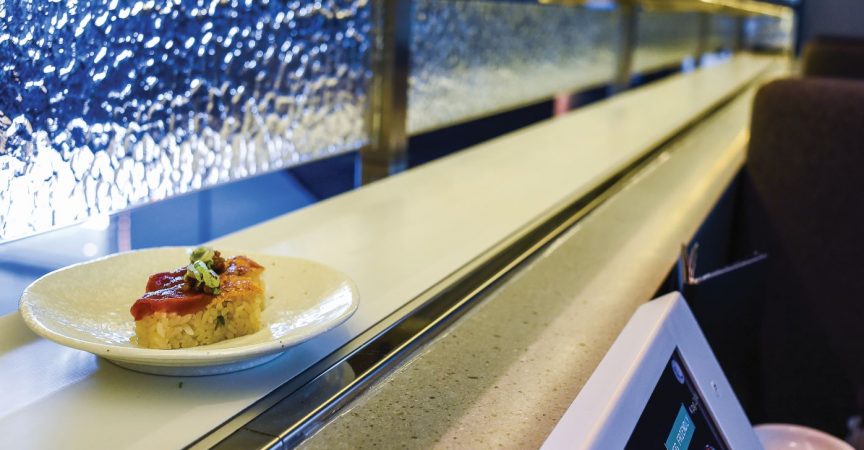Forward Thinking: Aburi’s Sushi Concierge System
I will admit that my gimmick alert blared when I received an email announcing a “futuristic eatery” where meals are delivered directly to tables via a conveyor belt-like system. But when I read further that the restaurant was the latest offering from Aburi, the people behind the innovative and wildly popular Miku Sushi restaurants in Vancouver and Toronto, I suspected there was likely to be substance behind the hype.
Located in Toronto’s Yorkdale Mall alongside Sporting Life and Restoration Hardware, TORA is accessed from an entrance on the main level. Once inside, diners take an elevator to the second floor. The narrow entrance opens to a spare but dramatic space filled with stainless steel, textured glass and grey upholstery—designed by Vancouver-based Ste. Marie Art Design.
The guest capacity is 140, including booths, a lounge and single bar seating.
The tables are lined at one end with double sets of wide laneways. Touch screens affixed to each table allow patrons to select their dishes and a pop-up alerts them when it is about to be served. Then, with a barely perceptible whirring sound, the plate emerges from an opening in a wall that conceals the kitchen and proceeds along the laneway to its destination. It takes 23 seconds for plates to travel from the kitchen to the last table on the laneway.
This tech concept—which TORA calls a sushi concierge—isn’t a frivolous experiment: it’s a solution to two challenges currently facing the industry, says Seigo Nakamura, owner of Aburi Restaurants Canada. “One is the increase of cost and the other is labour shortage. I think these issues will continue to grow and have an impact on the industry. My prediction is that skilled sushi chefs will only work in high-end restaurants, and restaurants with casual concepts will lose the potential for further growth.”
With less labour and highly trained chefs, TORA is able to provide quality sushi at a reasonable price by combining it with advanced technology, says Nakamura. “Just like when the smartphone was first introduced, this concept might not be accepted by the market as smoothly as we would hope, but I strongly believe that it will become normalized in the future. With the advancement of technology combined with the chef’s knowledge and experience, we will be able to provide even better and higher quality food and service at a lower price point.”
So, what about the food? While TORA may be the brand’s more affordable and casual iteration, its standards are on par with its swankier Aburi cohorts. That’s due to the fact that Miku serves as the company’s “sushi chef factory,” says Kazuya Matsuoka, Aburi’s corporate executive chef. “There’s a professional chef trained by Aburi behind the TORA wall.”
At the heart of the culinary approach is Aburi Oshi sushi. In Japanese, Aburi means “flame-seared,” while Oshi means “pressed.” The rice is compressed in boxes, topped with sauces and garnishes and flame-seared to bring out the natural umami flavour. Nakamura points out that a benefit of the straight-from-the-chef to the guest sushi-concierge system is that the sushi is served at “flame-seared” (body temperature), “which is usually only experienced at high-end sushi restaurants in Japan.”
TORA’s menu is rounded out with other hot (the Crispy Brussels Sprouts, $4.25, are a fun surprise) and cold dishes and desserts. The patron controls the timing, adding dishes as they wish and even signalling when they are ready to get the check through the intuitive interface platform. But it isn’t a totally human-free experience: servers still offer drinks and check in throughout.
TORA takes its name from Nakamura’s father’s restaurant Sushi TORA—in Miyazaki, Japan—which he took over in 1996 when he was only 20 years old. Ten years and many successful restaurants in Japan later, Nakamura brought his modern twist on traditional sushi to Canada, starting in Vancouver with the hugely successful Miku in 2008, followed by Minami, and Gyoza Bar. Miku Toronto opened in 2015.
This multi-brand strategy is part of Nakamura’s mission “to make Aburi sushi go beyond the category of Japanese cuisine,” he says. “While Miku is indeed our flagship concept, only so many people can experience our Aburi sushi at Miku. In order for us to introduce our Aburi sushi from Canada to the rest of the world, it is one of our visions that we make Aburi sushi more accessible to various global markets, with our various store concepts and multi-brand strategy.” (Hana, a more personal, higher-end restaurant concept, will open in Toronto this winter.)
Matsuoka says the intent is to capture an entire city’s demographics, offering venues for business lunches, celebrations and quick meals. “You need to think about [the] future. You can’t open a restaurant just because you make great food.”
So, what has the Aburi team learned from the TORA experience? “Technology is only a tool. We never compromise the quality. We always keep our eyes on the latest technological innovations that would further increase quality. It’s just a part of our business strategy.”
To that end, Matsuoka looked at five different suppliers for the laneways. “It was a tough process,” he says, because he had to consider efficiency, reliability and aesthetics.
Ultimately, says Nakamura, embracing technology is key to his company’s survival: “The implementation of advanced technology into daily operation within the industry will eventually become 100 per cent necessary due to the changing economic climate.”









